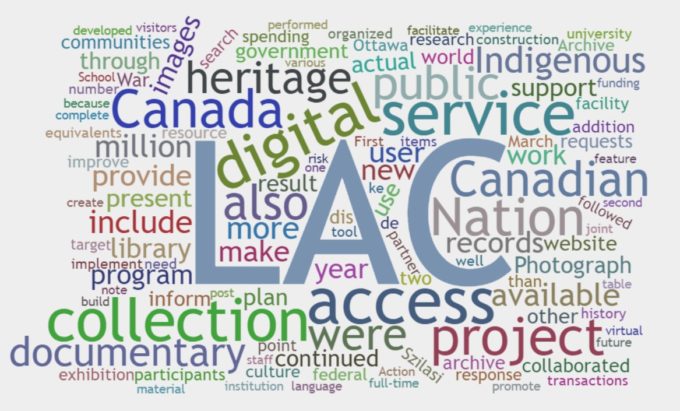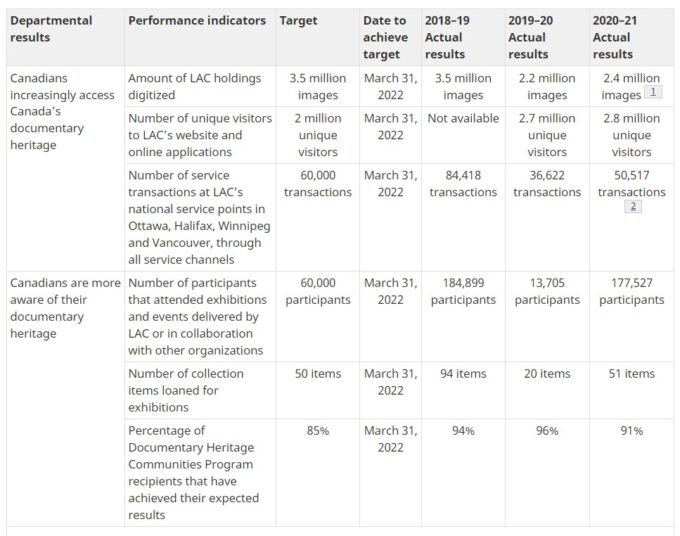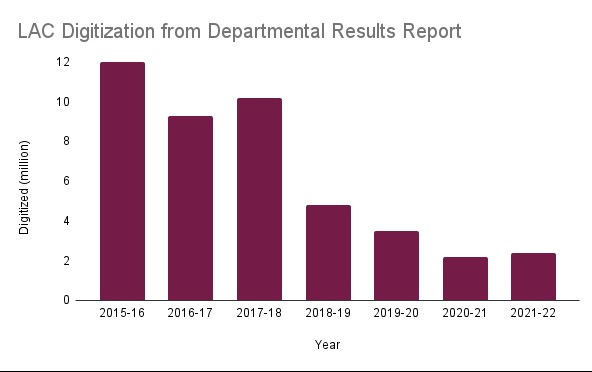 The annual Departmental Results Report, tabled in the Commons, is available here.
The annual Departmental Results Report, tabled in the Commons, is available here.
Included were five mentions of genealog*, one for census, and two for newspapers (both indigenous).
Considering the core responsibility of providing access to documentary heritage, the table shows four of the six performance targets were met or exceeded. Note that the column headings are incorrect, shifted back one year. LAC informs it will be corrected.

LAC fell short of the target of 3.5 million holdings (Images) digitized, to be achieved by 31 March 2022.
“In 2021–22, LAC digitized 2.4 million documentary heritage images, a crucial step in making them more accessible and in facilitating research for genealogy, litigation, land claims, agreements, inquiries and commissions.”
Of these images, 14,729 were digitized for LAC’s various Indigenous initiatives, and 274,598 as part of the Ādisōke project, the joint facility with OPL. LAC restored and resized 2,188 high-resolution digital watercolour images to make them available on both the LAC website and the portal of the international project entitled The Watercolour World.
LAC also processed 2,376,718 images (44,090 files) from Service Files of the Second World War – War Dead, 1939–1947. The records were digitized by one of LAC’s external partners, but substantial file manipulation and conversion were required to make the records available online (in 2022–23).
In a footnote LAC explains — “The target of 3.5 million images was not met for several reasons. The priority for digitization was support for reprography, ATIP requests and requests associated with the settlement of the Federal Indian Day School Class Action. The COVID-19 pandemic and health restrictions also impacted the absenteeism rate of staff who are normally required to be present at the worksite, which is the case for digitization staff. In addition to the digitization target, LAC processed 2.4 million images digitized by a partner to make them available on its website, which took eight months of work.”
Thanks to LAC for providing me the following.
As a result of an external digitization partnership in 2013-14, a selection of Service Files of the Second World War – War Dead, 1939–1947 were digitized. In accordance with the partnership agreement and after a seven-year exclusivity of these records on the partner’s site, the digitized copies were returned to LAC in 2021. In order for LAC to make these records available online, extensive processing and conversion of the files was required. The Digitization Services Division was responsible for this task. As a result of this project, 2,376,718 images contained in the 44,090 service files were processed. These records will be online and available to the public sometime in fiscal year 2022-2023.
The partner mentioned is Ancestry.ca; the records have been openly available online.
COMMENT
The target of 3.5 miilion images digitized, which was missed by 1.1 million images, was already inadequate. Here’s the historical record.

| Year | Digitized (million) |
| 2021-22 | 2.4 |
| 2020-21 | 2.2 |
| 2019-20 | 3.5 |
| 2018-19 | 4.8 |
| 2017-18 | 10.2 |
| 2016-17 | 9.3 |
| 2015-16 | 12 |
Google defines digitization as “the conversion of text, pictures, or sound into a digital form that can be processed by a computer.”
Would most people consider processing records scanned years ago, with online access through the partner, and now processed for online access on the LAC website, to be to be digitization?
But more important, why is LAC’s “digitization” goal so lacking in ambition when it’s the only affordable way to access LAC records for many of us across our large country?
In 2023 LAC will have the opportunity to show ambition isn’t lacking when the 1931 census is released to LAC from Statistics Canada’s control on 1 June.

